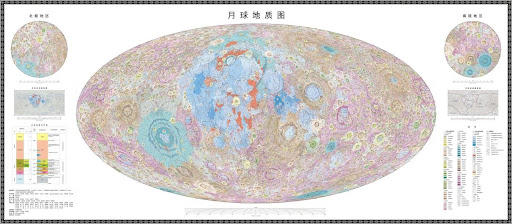By Wu Yuehui, People’s Daily
The first complete high-definition lunar geologic atlas in the world was released in Beijing on April 21. The atlas was drawn by a Chinese scientific research team mainly based on scientific exploration data from the Chang’e Project. With a scale of 1:2.5 million, it is the world’s most precise geological atlas of the whole moon.
This geologic atlas set, available in both Chinese and English, includes the Geologic Atlas of the Lunar Globe and the Map Quadrangles of the Geologic Atlas of the Moon. In particular, the Geologic Atlas of the Lunar Globe consists of the Geologic Map of the Moon, the Lithologic Map of the Moon and the Tectonic Map of the Moon. The Map Quadrangles of the Geologic Atlas of the Moon includes 30 standardized sub-schematic geological maps of the moon.
The world has been using the lunar geologic maps obtained by the Apollo program, but these maps can no longer meet the current and future needs of deep space exploration and scientific research.
Since 2012, academician Ouyang Ziyuan and researcher Liu Jianzhong of the Institute of Geochemistry of the Chinese Academy of Sciences (CAS), have led a team of scientists and cartographers from relevant research institutions in compiling a new-generation lunar geologic atlas set, including Jilin University, Shandong University, China University of Geosciences (Beijing), the Institute of Geology of Chinese Academy of Geological Sciences, and the CAS Institute of Geographic Sciences and Natural Resources Research.
With a comprehensive and systematic understanding of the origin and evolution of the moon, the team compiled the atlas based on scientific exploration data gained from China’s Chang’e lunar exploration program and other research results from both Chinese and international missions, Liu said.
By studying and collecting elements such as lunar rock formation, geological structure, and characteristics of the moon in different ages, China made technical specifications and standards of lunar geologic mapping with independent intellectual property rights, and compiled the 1:2.5 million digital lunar geologic atlas set.
A total of 12,341 impact craters, 81 impact basins, 17 types of lithologies and 14 types of structures all over the moon are mapped in the atlas.
A unified classification system for the sub-types of basin formations has been established. Besides, some special elements including landing sites of human probes and points of special elevation are also shown in the atlas.
The atlas set has been integrated into the digital lunar cloud platform built by Chinese scientists, and will serve lunar scientific research and science education, as well as landing site selection, lunar resource exploration and path planning for China’s future lunar exploration projects.













